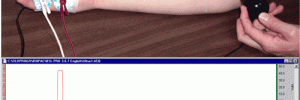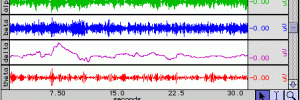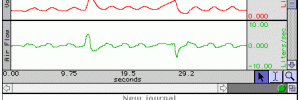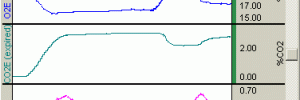
Combine the human-safe stimulating electrode with the stimulator to record nerve conduction experiments. Stimulate the ulnar nerve at three different points and record nerve conduction time. Measure the distance between the stimulation and recording points and then calculate the velocity of signal propagation along the nerve (motor response). Use the finger twitch transducer coupled with […]

Study EEG under a variety of conditions to explore relaxation and brain rhythms, software will filter and display each rhythm separately: alpha, beta, delta, and theta. Select from a variety of lessons to study alpha rhythms in the occipital lobe, reaction times, and hemispheric asymmetry. Add the EOG (occipital signal) to study eye movement, saccades, […]

Study EEG under a variety of conditions to explore relaxation and brain rhythmsthe software can filter and display each rhythm separately: alpha, beta, delta, and theta. Study alpha rhythms in the occipital lobe, reaction times, and hemispheric asymmetry. Use the system to demonstrate changes in the parasympathetic and sympathetic nervous system. Add EOG (occipital signal) […]

Study EEG under a variety of conditions to explore relaxation and brain rhythmssoftware will filter and display each rhythm separately: alpha, beta, delta, and theta. Select from a variety of lessons to study alpha rhythms in the occipital lobe, reaction times, and hemispheric asymmetry. Add the EOG (occipital signal) to study eye movement, saccades, tracking, […]

Implement simple experiments illustrating physiological control systems with the BSL System. Students can observe signal changes and then effect a change to observe a particular response. Investigate linear and nonlinear control paradigms. Create simple to intricate feedback loops where students perform a specific role in the loop operation. For instance, students can explore Westheimer’s saccadic […]
Biopac Science Lab comes with one lesson focused on respiration: Lesson 12 — Respiration I Apnea In Lesson 12, students observe physiologic modifications of the respiratory cycle associated with voluntarily increasing and decreasing blood carbon dioxide content by holding breath and hyperventilating. Students will qualitatively determine changes in respiratory minute volume by recording and analyzing […]

The BSL System provides an excellent introduction to Respiratory System & Pulmonary Function volumes and capacities, respiratory rates, breathing, and ventilation. Display and/or print a clinical grid on the data for effective interpretation and training. A complete range of airflow and pressure transducers is suitable for small, medium and large animals as well as humans.

Students can record the pattern of breathing as well as perform comprehensive cardiopulmonary tests. There are lessons for determining tidal volumes and lung capacities, including FEV1, 2, 3 and MVV, plus full gas analysis studies.

The BSL includes a range of experiments for pulmonary function and gas analysis studies. Detailed lessons guide students through the classical pulmonary function tests, including tidal volume, inspiratory capacity, expiratory capacity, functional residual capacity, vital capacity, total lung capacity, forced vital capacity, forced expiratory volume (FEV1,2,3) and Maximal Voluntary Ventilation (MVV).

The BSL provides an excellent introduction to volumes and capacities, respiratory flow rates, breathing mechanics, and ventilation. Display and/or print a clinical grid on the data for effective interpretation and training. The software guides the student in measuring FVC and in calculating FEV and MVV. The airflow transducer is hand-held, lightweight, easy to clean and […]








Stay Connected